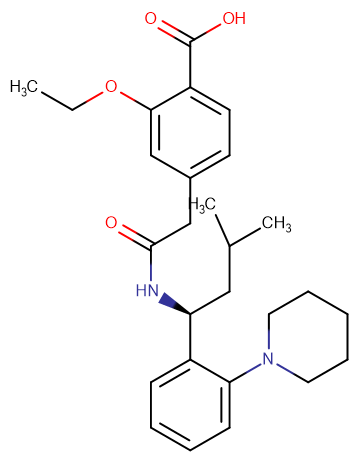
Repaglinide
CAS No. 135062-02-1
Repaglinide( Repaglinide | AG-EE 388 ZW | AG-EE388 ZW | AG-EE-388 ZW | AG-EE 623 ZW )
Catalog No. M11417 CAS No. 135062-02-1
Repaglinide is an oral antihyperglycemic agent used for the treatment of non-insulin-dependent diabetes mellitus (NIDDM).
Purity : >98% (HPLC)
 COA
COA
 Datasheet
Datasheet
 HNMR
HNMR
 HPLC
HPLC
 MSDS
MSDS
 Handing Instructions
Handing Instructions
| Size | Price / USD | Stock | Quantity |
| 25MG | 39 | In Stock |


|
| 50MG | 49 | In Stock |


|
| 100MG | 71 | In Stock |


|
| 200MG | 92 | In Stock |


|
| 500MG | Get Quote | In Stock |


|
| 1G | Get Quote | In Stock |


|
Biological Information
-
Product NameRepaglinide
-
NoteResearch use only, not for human use.
-
Brief DescriptionRepaglinide is an oral antihyperglycemic agent used for the treatment of non-insulin-dependent diabetes mellitus (NIDDM).
-
DescriptionRepaglinide is an oral antihyperglycemic agent used for the treatment of non-insulin-dependent diabetes mellitus (NIDDM). It belongs to the meglitinide class of short-acting insulin secretagogues, which act by binding to ? cells of the pancreas to stimulate insulin release. Repaglinide induces an early insulin response to meals decreasing postprandial blood glucose levels. It should only be taken with meals and meal-time doses should be skipped with any skipped meal. Approximately one month of therapy is required before a decrease in fasting blood glucose is seen. Meglitnides may have a neutral effect on weight or cause a slight increase in weight. The average weight gain caused by meglitinides appears to be lower than that caused by sulfonylureas and insulin and appears to occur only in those nave to oral antidiabetic agents. Due to their mechanism of action, meglitinides may cause hypoglycemia although the risk is thought to be lower than that of sulfonylureas since their action is dependent on the presence of glucose. In addition to reducing postprandial and fasting blood glucose, meglitnides have been shown to decrease glycosylated hemoglobin (HbA1c) levels, which are reflective of the last 8-10 weeks of glucose control. Meglitinides appear to be more effective at lowering postprandial blood glucose than metformin, sulfonylureas and thiazolidinediones. Repaglinide is extensively metabolized in the liver and excreted in bile. Repaglinide metabolites do not possess appreciable hypoglycemic activity. Approximately 90% of a single orally administered dose is eliminated in feces and 8% in urine.(In Vitro):Repaglinide reduces postprandial glucose levels by enhancing the early phase of insulin secretion and increasing the total amount of insulin secreted.(In Vivo):Repaglinide (AG-EE 623ZW) is very rapidly absorbed (tmax?less than 1 hour) with a t1/2?of less than one hour. Furthermore, Repaglinide is inactivated in the liver and more than 90 % excreted via the bile. Repaglinide (1 mg/kg p.o.) is effective (P<0.001) as an insulin-releasing agent in a rat model (low-dose streptozotocin) of type 2 diabetes.
-
In VitroRepaglinide reduces postprandial glucose levels by enhancing the early phase of insulin secretion and increasing the total amount of insulin secreted.
-
In VivoRepaglinide (AG-EE 623ZW) is very rapidly absorbed (tmax less than 1 hour) with a t1/2 of less than one hour. Furthermore, Repaglinide is inactivated in the liver and more than 90 % excreted via the bile. Repaglinide (1 mg/kg p.o.) is effective (P<0.001) as an insulin-releasing agent in a rat model (low-dose streptozotocin) of type 2 diabetes.
-
SynonymsRepaglinide | AG-EE 388 ZW | AG-EE388 ZW | AG-EE-388 ZW | AG-EE 623 ZW
-
PathwayCell Cycle/DNA Damage
-
TargetPotassium Channel
-
RecptorPotassium Channel| PPARγ
-
Research AreaMetabolic Disease
-
Indication——
Chemical Information
-
CAS Number135062-02-1
-
Formula Weight452.59
-
Molecular FormulaC27H36N2O4
-
Purity>98% (HPLC)
-
SolubilityEthanol: 91 mg/mL (201.06 mM); DMSO: 91 mg/mL (201.06 mM)
-
SMILESO=C(O)C1=CC=C(CC(N[C@H](C2=CC=CC=C2N3CCCCC3)CC(C)C)=O)C=C1OCC
-
Chemical Name2-ethoxy-4-[2-[[(1S)-3-methyl-1-(2-piperidin-1-ylphenyl)butyl]amino]-2-oxoethyl]benzoic acid
Shipping & Storage Information
-
Storage(-20℃)
-
ShippingWith Ice Pack
-
Stability≥ 2 years
Reference
1.Hansen AM, et al. Br J Pharmacol, 2005, 144(4), 551-557.
molnova catalog



related products
-
Chlorzoxazone
Chlorzoxazone is a centrally acting muscle relaxant used to treat muscle spasm and the resulting pain or discomfort.
-
Pinacidil monohydrat...
Pinacidil monohydrate is a potassium channel activator, antihypertensive drug.Pinacidil hydrate activates the ATP-modulated potassium channels of guinea pog bladder and heart with Ki of 104 and 251 nM, respectively.
-
TASK-1-IN-1
TASK-1-IN-1 is a potent and selective inhibitor of TASK-1 (Potassium Channel) with an IC50 of 148 nM, and exhibits a reduced inhibitory effect on the TASK-3 channel with an IC50 of 1750 nM. TASK-1-IN-1 also demonstrates anticancer effects.



 Cart
Cart
 sales@molnova.com
sales@molnova.com


